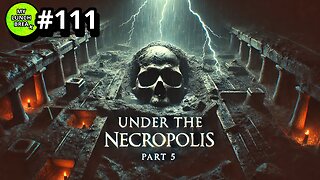Premium Only Content

Johann Christian Bach Sinfonia In D Major, Op 18, №3
#JohannChristianBach #SinfoniaInDMajor #Op18No3 #classicalmusic #orchestralcomposition #musicalanalysis #Baroqueinfluence #Classicalera #symphonyform #melodicbeauty #harmonicexploration #orchestration #musicalstructure #historicalcontext #enduringappeal
Publication date 1953
CHAMBER MUSIC SOCIETY ORCHESTRA
MAURITS VAN DEN BERG, Conductor
Johann Christian Bach, the youngest son of renowned composer Johann Sebastian Bach, left an indelible mark on the world of music. His Sinfonia In D Major, Op 18, No. 3, stands as a testament to his exceptional talent and unique musical style.
Johann Christian Bach composed the Sinfonia In D Major, Op 18, No. 3, during the late 18th century, a time when the classical style was flourishing. This symphony, also known as the "Italian" symphony, is a prime example of Bach's ability to combine elegance, grace, and emotional depth within a classical framework.
The Sinfonia In D Major follows the traditional symphonic structure of the time, consisting of three movements: the lively Allegro con spirito, the serene Andante, and the exuberant Presto. Each movement showcases Bach's mastery of melody, harmony, and orchestration.
The first movement, Allegro con spirito, immediately captivates the listener with its joyful and spirited melody. The lively tempo and intricate interplay between the orchestra's sections highlight Bach's meticulous attention to detail. The development section showcases the composer's ability to build tension and create musical depth.
The second movement, Andante, provides a contrasting mood to the previous movement. It unfolds with a graceful and lyrical melody, delicately carried by the strings. Bach's use of rich harmonies and expressive phrasing evokes a sense of tranquility and introspection.
The final movement, Presto, brings a burst of energy and exhilaration. Its brisk tempo and lively rhythms showcase Bach's ability to create excitement and momentum. The symphony reaches its grand finale with a thrilling and triumphant conclusion.
Johann Christian Bach's Sinfonia In D Major, Op 18, No. 3, holds significant historical and musical value. Its elegant melodies, masterful orchestration, and adherence to classical principles make it a prominent representative of the classical era. This symphony showcases Bach's innovative approach to composition, merging the influences of his father's Baroque style with the emerging classical trends of the time.
Moreover, Bach's Sinfonia In D Major, Op 18, No. 3, had a profound influence on subsequent composers. Its melodic inventiveness and expressive qualities paved the way for future symphonic works. Composers such as Wolfgang Amadeus Mozart and Ludwig van Beethoven drew inspiration from Bach's symphonies, contributing to the evolution of classical music.
Conclusion:
Johann Christian Bach's Sinfonia In D Major, Op 18, No. 3, is a true gem in the world of classical music. Its exquisite melodies, impeccable craftsmanship, and significant influence make it a remarkable composition. Through this symphony, Bach's legacy as a gifted composer and his contribution to the classical era are celebrated. The Sinfonia In D Major remains a testament to his enduring musical brilliance and continues to captivate audiences with its timeless beauty.
You have the opportunity to support the channel:
https://destream.net/live/RadSiarAl/donate
https://www.buymeacoffee.com/6355radsiaral
-
 6:07
6:07
Classical music_Music Inspiration
8 days agoJoseph Haydn Piano Sonata in D Major, Hob. XVI:51
361 -
 LIVE
LIVE
tacetmort3m
1 day ago🔴 LIVE - SOLO RANK GRINDING CONTINUES - MARVEL RIVALS
2,977 watching -
![Shadows Of Chroma Tower, Alpha Playtest [Part 1]](https://1a-1791.com/video/fwe2/1d/s8/1/5/Q/U/n/5QUnx.0kob-small-Shadows-Of-Chroma-Tower-Alp.jpg) 13:29:21
13:29:21
iViperKing
16 hours agoShadows Of Chroma Tower, Alpha Playtest [Part 1]
100K4 -
 54:05
54:05
TheGetCanceledPodcast
14 hours ago $12.36 earnedThe GCP Ep.11 | Smack White Talks Smack DVD Vs WorldStar, Battle Rap, Universal Hood Pass & More...
107K19 -
 13:37
13:37
Exploring With Nug
18 hours ago $7.11 earnedSUV Found Underwater Searching For Missing Man Jerry Wilkins!
71.6K4 -
 2:58:21
2:58:21
xBuRnTx
13 hours ago1st Warzone Stream Online
53.5K2 -
 6:10:21
6:10:21
JdaDelete
1 day ago $15.67 earnedDino Crisis - Sega Saturday
122K5 -
 23:22
23:22
MYLUNCHBREAK CHANNEL PAGE
1 day agoUnder The Necropolis - Pt 5
101K55 -
 2:26:11
2:26:11
Jewels Jones Live ®
2 days agoWINNING BIGLY | A Political Rendezvous - Ep. 108
157K47 -
 2:04:49
2:04:49
Bare Knuckle Fighting Championship
4 days agoBKFC FIGHT NIGHT MOHEGAN SUN FREE FIGHTS
82.5K7